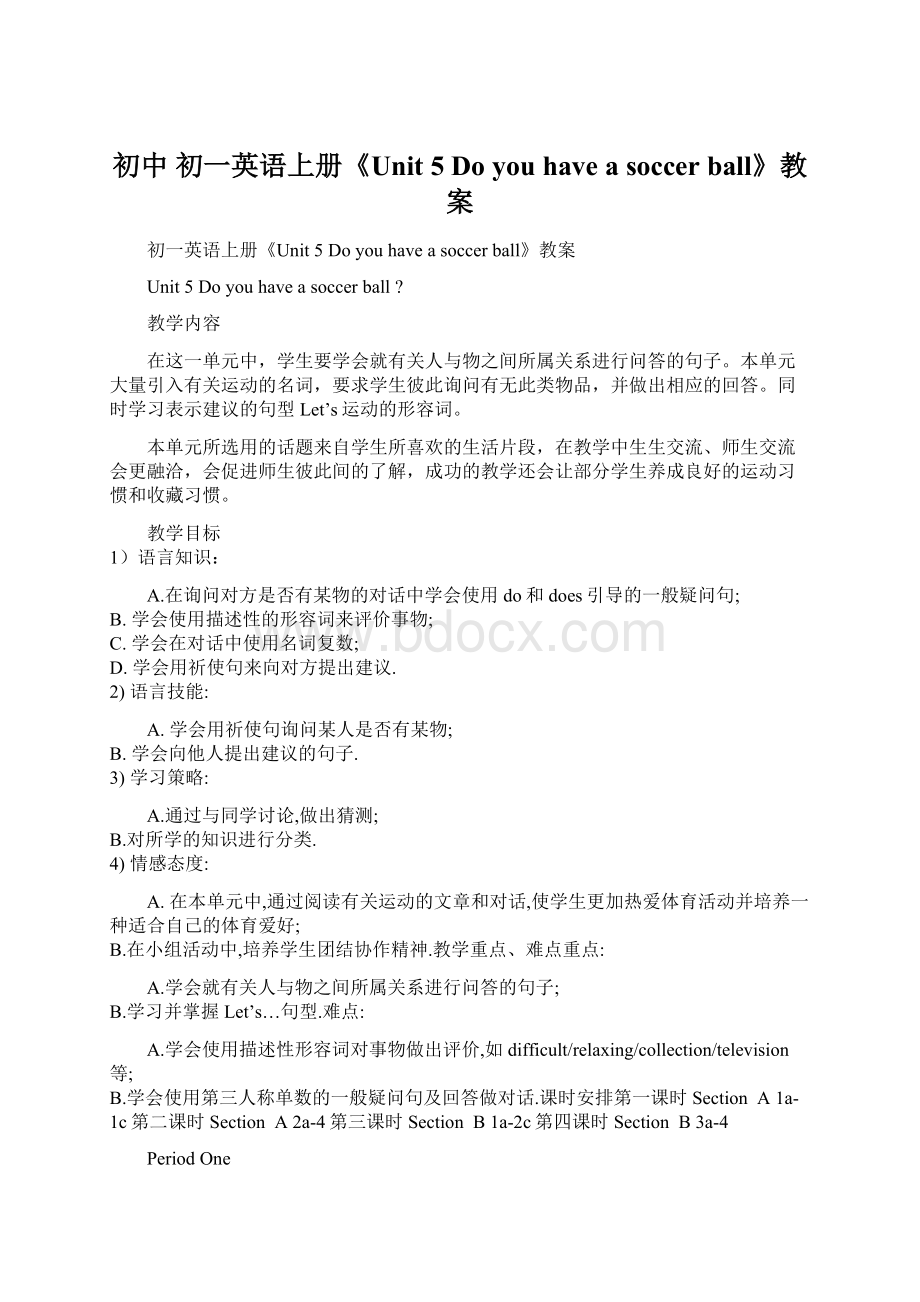 初中 初一英语上册《Unit 5 Do you have a soccer ball》教案.docx
初中 初一英语上册《Unit 5 Do you have a soccer ball》教案.docx
- 文档编号:11833686
- 上传时间:2023-04-05
- 格式:DOCX
- 页数:14
- 大小:20.75KB
初中 初一英语上册《Unit 5 Do you have a soccer ball》教案.docx
《初中 初一英语上册《Unit 5 Do you have a soccer ball》教案.docx》由会员分享,可在线阅读,更多相关《初中 初一英语上册《Unit 5 Do you have a soccer ball》教案.docx(14页珍藏版)》请在冰豆网上搜索。

初中初一英语上册《Unit5Doyouhaveasoccerball》教案
初一英语上册《Unit5Doyouhaveasoccerball》教案
Unit5Doyouhaveasoccerball?
教学内容
在这一单元中,学生要学会就有关人与物之间所属关系进行问答的句子。
本单元大量引入有关运动的名词,要求学生彼此询问有无此类物品,并做出相应的回答。
同时学习表示建议的句型Let’s运动的形容词。
本单元所选用的话题来自学生所喜欢的生活片段,在教学中生生交流、师生交流会更融洽,会促进师生彼此间的了解,成功的教学还会让部分学生养成良好的运动习惯和收藏习惯。
教学目标
1)语言知识:
A.在询问对方是否有某物的对话中学会使用do和does引导的一般疑问句;
B.学会使用描述性的形容词来评价事物;
C.学会在对话中使用名词复数;
D.学会用祈使句来向对方提出建议.
2)语言技能:
A.学会用祈使句询问某人是否有某物;
B.学会向他人提出建议的句子.
3)学习策略:
A.通过与同学讨论,做出猜测;
B.对所学的知识进行分类.
4)情感态度:
A.在本单元中,通过阅读有关运动的文章和对话,使学生更加热爱体育活动并培养一种适合自己的体育爱好;
B.在小组活动中,培养学生团结协作精神.教学重点、难点重点:
A.学会就有关人与物之间所属关系进行问答的句子;
B.学习并掌握Let’s…句型.难点:
A.学会使用描述性形容词对事物做出评价,如difficult/relaxing/collection/television等;
B.学会使用第三人称单数的一般疑问句及回答做对话.课时安排第一课时Section A1a-1c第二课时Section A2a-4第三课时Section B1a-2c第四课时Section B3a-4
PeriodOne
课前准备教师:
准备表格、铅笔、格尺或橡皮。
学生:
调查。
教学设计StepOne:
Learnthenewwords. 1. Presentthekeyvocabulary.
(Showabasketballtotheclass.)
T:
What’sthisinEnglish?
S1:
It’sabasketball.
T:
Yes,youareright.Readafterme.B-A-S-K-E-T-A-B-L-L,basketball.
Ss:
B-A-S-K-E-T-A-B-L-L,basketball.
(Showthestudentsotherobjects.Teachthenewwords“tennisracket,ping-pongball,volleyball,basketball”inthesameway.Andthenshowstudentsthepictureoftelevisionandteachit.)
T:
Readthewordstogethertwice.
Ss:
…
T:
Askandanswerinpairswiththesethings.Usethedrill“What’sthisinEnglish?
”and“Whereisthe..?
”
2. Lookatthewordsin1aandmatchthewordswiththethingsinthepicture.
T:
Number1is(c),tennisracket.What’sNumber2Matchthem.
3. Askonestudenttoshowtheanswersandcheckthem.
StepTwo:
Presentthestructures.
1. Presentthesequestionsandanswers.
(Pointtoastudentwhohasapenorapencilcase.)
T:
Doyouhaveapencilcase?
S1:
Yes,Ido.(Nodyourheadyes)
T:
Doyouhaveacomputergame?
S1:
No,Idon’t.(Shakeyourheadno)
2. Practicethedrill“Doyouhavea…?
”inpairs.Youcanuseyourschoolthingsandtheseballs.Lookatthemodel,thenpracticelikethis.
Model:
Sa:
Doyouhaveabackpack?
Sb:
Yes,Ido.Doyouhaveasoccerball?
Sa:
No,Idon’t.Ihaveavolleyball.
(Studentsworkinpairs.)
StepThree:
Listeningpractice.
T:
Lookatthefouritemsof1binthepictures.Listentotheconversation.
(Playtherecordingof1bthefirsttime.Studentsonlylisten.)
T:
Listentotheconversationandcirclethewordsyouhear.
(Playtherecordingagain.)
T:
Checktheiranswers.
S:
…
StepFour:
Practicetheconversations.
1. Readtheconversationsin1c.
(Askstudentstorepeat.)
2. Lookatthepicturein1aandpracticetheconversationwitheachotherinpairs.
S1:
Doyouhave…?
S2:
Yes,Ido.
S1:
Doyouhavea…?
S2:
No,Idon’t.
3. Workingroupsoffourandusethepicturetopracticethesimilarconversationswiththenewwords.(television,basketball,baseballbat,soccerball,volleyball,television)
T:
Askandanswerthequestionsasmanyasyoucan.
S1:
Doyouhavea…?
S2:
…
S1:
…
S2:
…
StepFive:
Task.
T:
Makeasurveyabout“Whatkindofballsdothestudentshave?
”Wewanttohaveaballgame.Butwedon’tknowwhatkindofballsyouhave.Pleaseaskyourclassmatesinthegroupwhatballshe/shehas.Thenwritedowntheinformationinthechart.
1.Fillinthechartusingthestructureandmodelsonthescreen.
Names
Doyouhave…?
Ballsyouhave
1
2
3
4
5
Structures:
Doyouhavea…?
Yes,Ido./No,Idon’t.
Whatballsdoyouhave?
Ihavea…
Example:
S1:
Doyouhaveatennisracket,Tom?
S2:
No,Idon’t.
S1:
Whatballsdoyouhave?
S2:
Ihavebasketballandfootball.
S1:
Whataboutyou?
S3:
…
2.Chooseonestudentfromeachgrouptoreportabouthisorhergroup.
Reportlikethis:
Sheorhelikes…Oneofthemhasa…Buttwoofthemhave…
StepSix:
Homework.
Makeasurveyaboutyourparents’collection.
Name
collection
Mother
father
Unit5Doyouhaveasoccerball?
PeriodTwo
课前准备教师:
设计表格,准备录音机及多媒体课件。
学生:
准备卧室照片。
教学设计
StepOne:
Warmingup.
1. Presentthenewstructures.
T:
Doyouhaveatennisracket?
S1:
Yes,Ido.
T:
Doyouhaveabaseballbat?
S2:
No,Idon’t.
T:
Doesshehaveatennisracket?
(Pointtothefirststudent)
S3:
Yes,shedoes.
T:
Doeshehaveabaseballbat?
(Pinttothesecondstudent)
S4:
No,hedoesn’t.
2. Practicethedrill.
T:
Practiceingroupsoffour.Thefirsttwostudentsmustusethedrill“Doyouhavea…?
”Theothertwostudentsaskandansweraccordingtotheirconversationandusethedrill“Doeshe/shehavea…?
”
S1:
Doyouhavea…?
S2:
Yes,Ido.Doyouhavea…?
S1:
No,Idon’t.
S3:
Doesshehavea…?
S4:
Yes,shedoes.Doeshehavea…?
S3:
No,hedoesn’t.
StepTwo:
Listening.
T:
Lookatthepicturesin2bandnamethem.Whatarethese?
(Pointatthebaseball,basketball,volleyball,football.)
Ss:
Theyare…
T:
Therearefourchildrenintheconversations.Whoarethey?
Pleaselistenandfindtheanswer.
(Playtherecorderforthefirsttime.)
S:
…
T:
I’llplaytherecorderforthesecondtime.Listenandnumberthepictures(1-4).
(Studentslistenforthesecondtime.)
T:
Listentotheconversationin2b.Matchthepeoplewiththeballs.
(Studentslistenandmatch.Teachercheckstheiranswer.)
StepThree:
Practicethestructure:
Doyouhavea…?
Yes,Ido./No,Idon’t.
T:
Now,Pleaselookatthepicturein2cinyourbook.Supposethisisyourpartner’sroom.Askyourpartner“Doyouhavea…?
”
(Showaphotooftheteacher.)
Sa:
Doyouhavea…?
Sb:
Yes,Ido./No,Idon’t.
T:
Thisismyroom.Askyourpartnersomequestionsaboutit.Makethesameconversationlikethis.
Model:
T:
Let’slookattheteacher’sroom.Doesshe/hehaveafootball?
S1:
Yes,she/hedoes.Doesshe/hehaveaping-pong?
T:
No,she/hedoesn’t.
(Askmorestudentstomakeaconversation.)
T:
Makealongconversationwiththingsinthepicture.
S:
…
T:
Takeoutyourpicturesandchangeeachother.Pleasetalkaboutit.
S:
…
StepFour:
Learnhowtomakesuggestions.
1. Presentthenewword:
Let’s…
(Showafootballtoclass.)
T:
Let’splayfootballafterclass,OK?
S1:
OK.
T:
Let’splayping-pong.
S2:
OK.
T:
Weoftenusethedrill“Let’s…”tomakeasuggestion.Ifyouwanttodoit,youmaysay“OK./Thatsoundsgood./Allright…”Ifyoudon’twanttodoit,youmaysay“No,Idon’thavea…”
(Theteacherwritesthedrillonthebackboard.)
A:
Let’splay…
B:
No,Idon’thavea…
A:
Well,let’splaybaseball.
B:
Thatsoundsgood.
T:
“Thatsoundsgood”means“ThatisagoodideaorThatwouldbefun”.
2. Do3a.
(Theteacherreadsthecartoonstoryin3aforstudents,sayingblankeachtimeyoucometoanemptywrite-online.
T:
I’llaskastudenttoreadthefourwordstotheclass.
S:
…
T:
Fillintheblankswiththewordsfromthebox.
(Studentsworkaloneastheywritethefourwordsfromtheboxinthecorrectbanks.)
T:
Checktheanswers.
S:
..
StepFive:
Practicethestructure:
Let’s…
1. Explaining.
T:
Lookatthethreepicturesin3bandnamethethingsinit.
S:
…
T:
WhatdoesthemarkonthebasketballinPictureOnemean?
Themarkmeans“don’t”or“no”andmeans“doit”.
T:
Whoreadtheconversationinpairs?
S:
…
2. Pairwork.
T:
Makeconversationswithyourpartneraccordingtothepicture.
Sa:
Let’splaybaseball.
Sb:
Idon’thavea…
Sa:
Well,let’splay…
Sb:
…
StepSix:
Task.
JointheSchoolSportCenter.
T:
Lookatthead.Onthescreen.Whatsportsdoyouliketoplay?
Whoareyourfavoritesportsmenandsportswomen?
Whatsportsdoyouplayattheschool?
OurschoolhasaSportsCenterwithallthesportsthatyouwouldliketoplay.
WelcometoourSportsCenter.
Doyoulikesports?
Wehavemany
Clubs:
volleyball,basketball,ping-pongandmore.Joinus.
1. Readthead.andfillinthechart.
2. Readthead.forstudentsandaskthemtorepeatthenewwords.
3. Askstudentstochooseoneclubandfillintheform.
4. Makeaconversationwithonestudentusingtheform.
Structures:
What’syourfirstname?
What’syourlastname?
Whatsportsdoyoulike?
Doyoulike…?
Whatclassareyouin?
Howoldareyou?
Application(申请)
Firstname
Lastname
Age
Sex
Class
Club
Forexample:
S1:
What’syourfirstname?
S2:
Mynameis…
S1:
What’syourlastname?
S2:
Mylastnameis…
S1:
Whatsportsdoyoulike?
S2:
Ilikebasketball.
S1:
Whoisthesportstaryoulike?
S2:
YaoMing.
S1:
Doyoulikebaseball?
S2:
No,Idon’t.
S1:
OK,youcanjoinourbasketclub.Welcomeyou.
5. Changethepartnerandmakeanotherconversation.
Structures:
Whatsportsdoeshelike?
Doeshe/shelike…?
Unit5Doyouhaveasoccerball?
PeriodThree
课前准备教师:
准备表格,录音机。
学生:
准备调查。
教学设计
StepOne:
Warmingup.
1. Presentthestructureoflastlesson.
(showavolleyballtoastudent)
T:
Let’smakeaconversationaboutyoursportyoulike.Doyoulikevolleyball?
S1:
Yes,Ilikeitverymuch.
(Showabaseballtohimorher.)
T:
Whataboutbaseball?
S1:
No,Idon’t.Idon’tlikeit.
T:
OK.Let’splayvolleyballafterclass.
S1:
Great.
2. Workinpairsandmakeasimilarconversationlikethis.
StepTwo:
Learnthenewwords.
1. Readthewordsin1a.
(Pointtothefivewordsin1aandaskstudentstorepeateachone.)
Ss:
interesting,fun,relaxing,boring,difficult.
2. ExplaintheChinesemeaningofthem.
3. Thenmatcheachpicturewithoneofthewords.
(Pointtothefivepicturesandaskstudentstomatchthem.)
4. Correcttheanswer.
StepThree:
Practicethenewwords.
1. Askandanswerusingthedescriptionwordslikethis.
(Writethelistofthesubjectstodayontheblackboard.Teacherpointstothesubjects.Studentssaythedescriptionwords.)
T:
Ismathrelaxing?
Ss:
No,it’sboring.
T:
Nowworkinpairs.
2. Practiceusingyourpictures.
T:
Pleasedrawpi
- 配套讲稿:
如PPT文件的首页显示word图标,表示该PPT已包含配套word讲稿。双击word图标可打开word文档。
- 特殊限制:
部分文档作品中含有的国旗、国徽等图片,仅作为作品整体效果示例展示,禁止商用。设计者仅对作品中独创性部分享有著作权。
- 关 键 词:
- Unit 5 Do you have a soccer ball 初中 初一英语上册Unit Do you have soccer ball教案 初一英语 上册 Unit ball 教案
 冰豆网所有资源均是用户自行上传分享,仅供网友学习交流,未经上传用户书面授权,请勿作他用。
冰豆网所有资源均是用户自行上传分享,仅供网友学习交流,未经上传用户书面授权,请勿作他用。
链接地址:https://www.bdocx.com/doc/11833686.html


 铝散热器项目年度预算报告.docx
铝散热器项目年度预算报告.docx
